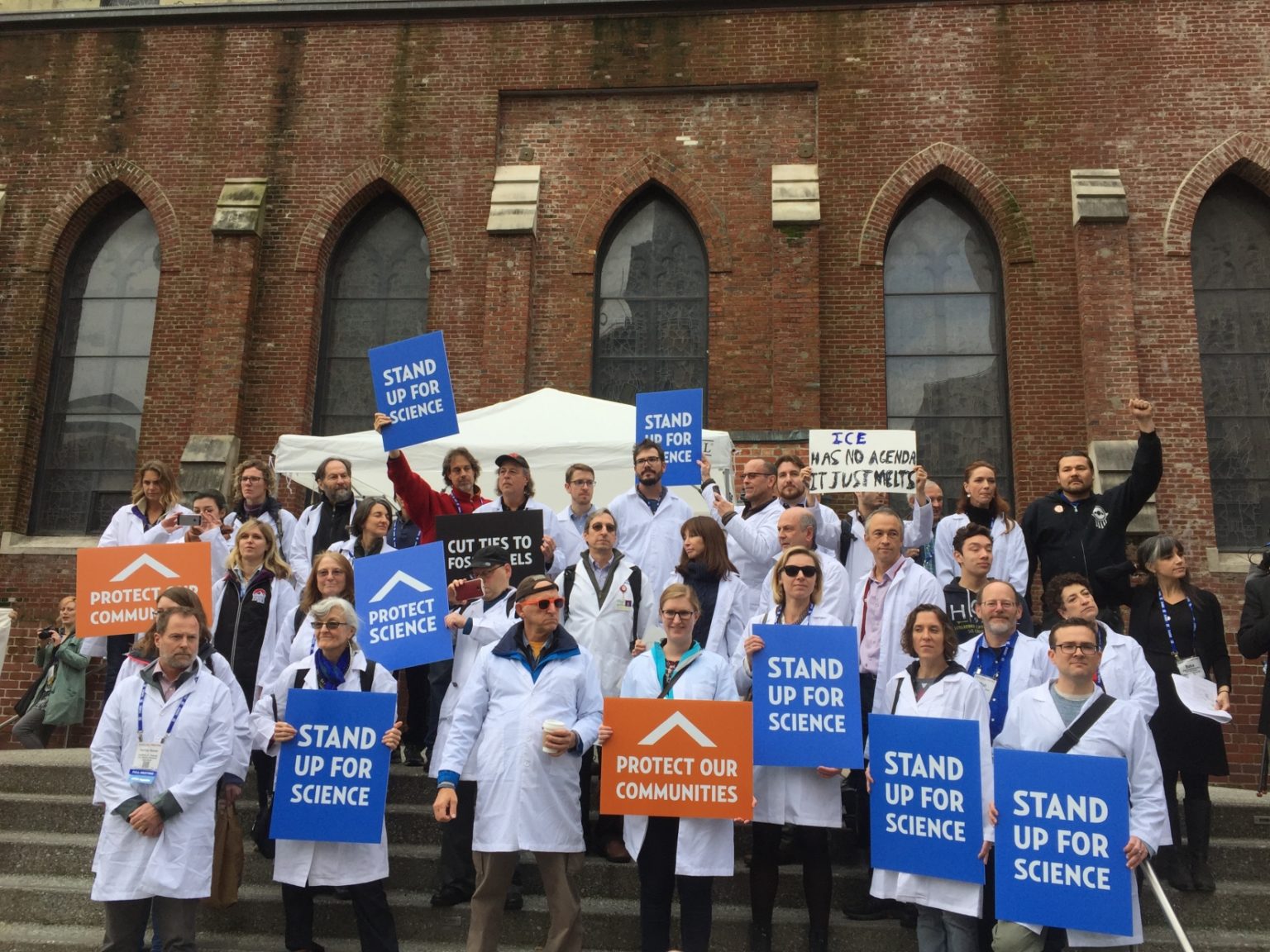On a gray afternoon in downtown San Francisco, hundreds of scientists and supporters held a rally to “champion the role of science in society,” while the news of President-elect Donald Trump’s latest cabinet appointment of a fossil fuel industry ally and climate denier, Rick Perry, reverberated through the air like the bells of a nearby church.
“As scientists, it’s not enough just to do our science,” Harvard social scientist Naomi Oreskes told the crowd. “We have to get out and explain to people why the science matters to them, to their lives, to their jobs, to their communities, to their health and well-being, and to their prosperity.”
Many of the scientists at the rally were attending the American Geophysical Union’s Fall Meeting, which attracts more than 25,0000 earth and space scientists and has been the largest gathering of climate scientists since the November presidential election.
Credit: DeSmog
While scientists have a reputation for adhering to what some might call an overly rigid sense of objectivity, the rally today was meant to, in the words of one of the organizers, “let the world know we’re getting out from our labs into the streets.”
Clad in white lab coats and holding signs with messages such as “Protect science” and “Ice has no agenda. It just melts,” scientists today made their presence known.
Oreskes, who has been outspoken about industry attempts to cast doubt on the validity of climate science, reinforced this message that in this “frightening moment,” scientists need to step out of their comfort zones to defend themselves and their work.
“A lot of us have been a little bit complacent. A lot of us, especially scientists, have thought it’s not our job; it’s someone else’s job,” Oreskes said in her address. “But it is our job. It’s all of our jobs.”
She was not alone.
“I’m here because science is under attack by very powerful political forces who are putting their own commercial interests ahead of the welfare of humanity,” said cognitive scientist Stephan Lewandowsky of the University of Bristol.
Lewandowsky has studied how false information, such as that about climate change or vaccinations, spreads through societies and what factors influence whether people accept scientific evidence or not.
He and his collaegues have a forthcoming study which concludes that facts don’t sway voting intentions or feelings about candidates, even if people learn that their candidate is making false statements.
Scientists took a break from the largest gathering of earth and space scientists to rally against the anti-science stances of the incoming Trump administration. Credit: Michael Tobis
Sarah Myhre, a postdoctoral scholar at the University of Washington with the Future of Ice Initiative and School of Oceanography, was also attending the rally. In comments to DeSmog, she spoke passionately about the importance of evidence-based, rather than politically motivated, science.
Pointing out a nearby building being constructed with the benefit of engineering and material science, Myhre lamented that the science of Earth’s climate is being unfairly targeted by industry and the incoming administration.
“I am here to stand up for evidence, for my community of scientists,” she told DeSmog. “I’m here for the future of the communities and economies that I call home. I’m here to do the right thing and it’s because I care.”
Another speaker at the rally was paleoclimatologist Kim Cobb of Georgia Tech, who described her experience earlier this year of seeing 85% of a coral reef she was studying in the tropical Pacific die in the six months between her research trips.
“We have for too long as scientists rested on the assumption that by providing indisputable facts and great data that we are providing enough of an attack to counter the forces against science, and obviously that strategy has failed miserably,” said Cobb.
She thanked the crowd of scientists who were present but wondered aloud about the thousands of others still at the AGU conference down the street.
“I say whatever is holding you back if you’re a scientist, what are you waiting for?” she said.
Glaciologist Bob Hawley of Dartmouth College tried to attend the rally, but found conflicting information about its start time and had to leave before the event really got started.
He offered part of a response to Cobb: “I think that the main issue that I saw is there are so many other side meetings happening at AGU. Everybody is too busy and it’s very difficult for us to get out of those silos and come out to the square. I was glad I was able to get out there for 15 minutes before I had to go to my other meeting, but I was sad that I couldn’t be there for longer and put on a white lab coat.”
The rally was organized by the Natural History Museum and ClimateTruth.org, and also featured speakers from organizations representing communities impacted by climate change, such as Amazon Watch, Idle No More, and Communities for a Better Environment.
Watch Oreskes address the crowd:
Subscribe to our newsletter
Stay up to date with DeSmog news and alerts







